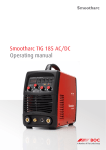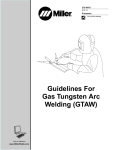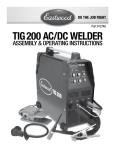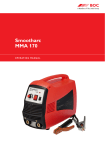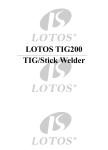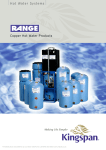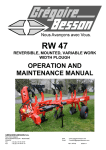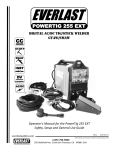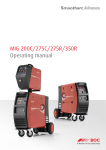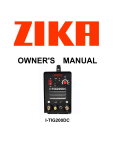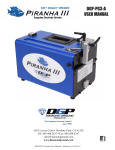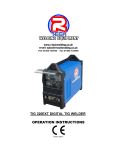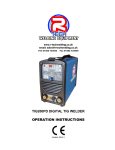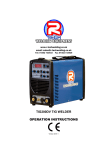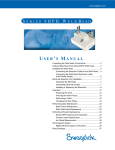Download Tig200 DC Digital Tig Welder Operating Instructions - R
Transcript
www.r-techwelding.co.uk Email: [email protected] Tel: 01452 733933 Fax: 01452 733939 Tig200 DC Digital Tig Welder Operating Instructions Important Notice: This document has been prepared by R-Tech Welding Ltd. as general information and does not contain and is not to be taken as containing any specific recommendation.The document has been prepared in good faith and is professional opinion only. Information in this document has been derived from third parties, and though R-Tech Welding Ltd believes it to be reliable as at the time of printing, R-Tech Welding makes no representation or warranty as to the accuracy, reliability or completeness of information in this document and does not assume any responsibility for updating any information or correcting any error or omission which may become apparent after the document has been issued. Neither R-Tech Welding nor any of its agents has independently verified the accuracy of the information contained in this document.The information in this document is commercial in confidence and is not to be reproduced.The recipient acknowledges and agrees that it must make its own independent investigation and should consider seeking appropriate professional recommendation in reviewing and evaluating the information.This document does not take into account the particular circumstances of the recipient and the recipient should not rely on this document in making any decisions, including but not limited to business, safety or other operations decisions. Except in so far as liability under any statute cannot be excluded, R-Tech Welding and its affiliates, directors, employees, contractors and consultants do not accept any liability (whether arising in contract, tort or otherwise) for any error or omission in this document or for any resulting loss or damage (whether direct, indirect, consequential or otherwise) suffered by the recipient of this document or any other person relying on the information contained herein.The recipient agrees that it shall not seek to sue or hold R-Tech Welding or their respective agents liable in any such respect for the provision of this document or any other information. Contents 1.0 Recommended Safety Precautions 1.1 Health Hazard Information 6 1.2 Personal Protection 6 1.3 Electric Shock 8 1.4 User Responsibility 8 2.0 Gas Tungsten Arc Welding (GTAW/TIG) 2.1 Introduction 9 2.2 Process 9 2.3 Process Variables 9 2.4 Shielding Gas Selection 11 2.5 Consumable Selection 12 2.6 Welding Techniques 13 2.7 Torch Movement During Welding 2.8 Joint Preparation 8 17 3.0 TIG Welding of Materials 3.1 Application Summary 21 3.2 C-Mn Steel 22 3.3 Alloyed Steel 23 3.4 Stainless Steel 24 3.5 Aluminium 25 3.6 Balanced Squarewave 25 3.7 Copper and Copper Alloys 26 4.0 Connection Your R-Tech TIG200DC PFC 4.1 Power 28 4.2 Shielding Gas 28 4.3 TIG Torch Connection 28 4.4 MMA Operation 28 4.5 TIG Welding Operation 29 5.0 Technical Specifications 32 6.0 Warranty 6.1 Terms of Warranty 33 6.2 Limitations on Warranty 33 6.3 Warranty Repairs 33 1 1.0 Recommended Safety Precautions 1.1 Health Hazard Information The actual process of welding is one that can cause a variety of hazards.All appropriate safety equipment should be worn at all times, i.e. headwear, respiratory, hand and body protection. Electrical equipment should be used in accordance with the manufacturers recommendations. Eyes: The process produces ultra violet rays that can injure and cause permanent damage. Fumes can cause irritation. Skin: Arc rays are dangerous to uncovered skin. Fumes from the welding of some metals could have an adverse effect on your health. Don ’t breathe them in. If you are welding on material such as stainless steel, nickel, nickel alloys or galvanised steel, further precautions are necessary. Wear a respirator when natural or forced ventilation is not good enough. Eye protection A welding helmet with the appropriate welding filter lens for the operation must be worn at all times in the work environment.The welding arc and the reflecting arc flash gives out ultraviolet and infrared rays. Protective welding screen and goggles should be provided for others working in the same area. Inhalation: Welding fumes and gases are dangerous to the health of the operator and to those in close proximity.The aggravation of pre-existing respiratory or allergic conditions may occur in some workers. Excessive exposure may cause conditions such as nausea, dizziness, dryness and irritation of eyes, nose and throat. 1.2 Personal Protection Respiratory Confined space welding should be carried out with the aid of a fume respirator or air supplied respirator as per AS/NZS 1715 and AS/NZS 1716 Standards. You must always have enough ventilation in confined spaces. Be alert to this at all times. Keep your head out of the fumes rising from the arc. 2 Clothing Suitable clothing must be worn to prevent excessive exposure to UV radiation and sparks.An adjustable helmet, flameproof loose fitting cotton clothing buttoned to the neck, protective leather gloves, spats, apron and steel capped safety boots are highly recommended. Recommended filter shades for arc welding Less than 150 amps Shade 10* 150 to 250 amps Shade 11* 250 to 300 amps Shade 12 300 to 350 amps Shade 13 Over 350 amps Shade 14 *Use one shade darker for aluminium Cylinder Safety Cylinder Valve Safety When working with cylinders or operating cylinder valves, ensure that you wear appropriate protective clothing gloves, boots and safety glasses. When moving cylinders, ensure that the valve is not accidentally opened in transit. Before operating a cylinder valve: Ensure that the system you are connecting the cylinder into is suitable for the gas and pressure involved. Ensure that any accessories (such as hoses attached to the cylinder valve, or the system being connected to) are securely connected. Ten Points about Cylinder Safety 1 Read labels and Material Safety Data Sheet A hose, for example, can potentially flail around dangerously if it is accidentally (MSDS) before use. pressurised when not restrained at both ends. 2 Store upright and use in well ventilated, Stand to the side of the cylinder so that secure areas away from pedestrian or vehicle neither you nor anyone else is in line with thoroughfare. the back of the cylinder valve.This is in case a back-plus is loose or a bursting disc vents.The 3 Guard cylinders against being knocked correct stance is shown in the diagram above. violently or being allowed to fall. 4 Wear safety shoes, glasses and gloves when handling and connecting cylinders. 5 Always move cylinders securely with an appropriate trolley.Take care not to turn the valve on when moving a cylinder. 6 Keep in a cool, well ventilated area, away from heat sources, sources of ignition and combustible materials, especially flammable gases. 7 Keep full and empty cylinders separate. 8 Keep ammonia-based leak detection solutions, oil and grease away from cylinders and valves. 9 Never use force when opening or closing valves. 10 Don’t repaint or disguise markings and damage. If damaged, return cylinders to your local supplier. When operating the cylinder valve: Open it by hand by turning the valve handwheel anti-clockwise. Use only reasonable force. Ensure that no gas is leaking from the cylinder valve connection or the system to which the cylinder is connected. DO NOT use ammonia-based leak detection fluid as this can 3 damage the valve.Approved leak detection fluid can be obtained from a gas supplier When finished with the cylinder, close the cylinder valve by hand by turning the valve hand-wheel in a clockwise direction. Use only reasonable force. 1.3 Electrical Shock Never touch live electrical parts. Always repair or replace worn or damaged parts. Disconnect power source before performing any maintenance or service. Earth all work materials. Never work in moist or damp areas. Avoid electric shock by: Wearing dry insulated boots Wearing dry leather gloves Never changing electrodes with bare hands or wet gloves Never cooling electrode holders in water Working on a dry insulated floor where possible Never hold the electrode and holder under your arm. 1.4 User Responsibility Read the Operating Manual prior to installation of this machine. Unauthorised repairs to this equipment may endanger the technician and operator and will void your Warranty. Only qualified personnel approved by R-Tech Welding should perform repairs. Always disconnect mains power before investigating equipment malfunctions. Parts that are broken, damaged, missing or worn should be replaced immediately. Equipment should be cleaned periodically. 4 PLEASE NOTE that under no circumstances should any equipment or parts be altered or changed in any way from the standard specification without written permission given by R-Tech Welding.To do so, will void the Equipment Warranty. 2.0 Gas Tungsten Arc Welding (GTAW/TIG) 2.1 Introduction The Tungsten Inert Gas, or TIG process, uses the heat generated by an electric arc struck between a non-consumable tungsten electrode and the workpiece to fuse metal in the joint area and produce a molten weld pool.The arc area is shrouded in an inert or reducing gas shield to protect the weld pool and the nonconsumable electrode.The process may be operated autogenously, that is, without filler, or filler may be added by feeding a consumable wire or rod into the established weld pool. 2.2 Process Direct or alternating current power sources with constant current output characteristics are normally employed to supply the welding current. For DC operation the tungsten may be connected to either output terminal, but is most often connected to the negative pole. The output characteristics of the power source can have an effect on the quality of the welds produced. Shielding gas is directed into the arc area by the welding torch and a gas lens within the torch distributes the shielding gas evenly over the weld area. In the torch the welding current is transferred to the tungsten electrode from the copper conductor.The arc is then initiated by one of several methods between the tungsten and the workpiece. 2.3 Process Variables DCEN When direct-current electrode-negative (straight polarity) is used: Electrons strike the part being welded at a high speed. Intense heat on the base metal is produced. The base metal melts very quickly. Ions from the inert gas are directed towards the negative electrode at a relatively slow rate. Direct current with straight polarity does not require post-weld cleaning to remove metal oxides. 5 Use of DCEN For a given diameter of tungsten electrode, higher amperage can be used with straight polarity. Straight polarity is used mainly for welding: Carbon steels Stainless steels Copper alloys The increased amperage provides: Deeper penetration Increased welding speed A narrower, deeper, weld bead. Use of DCEP Intense heat means a larger diameter of electrode must be used with DCEP. Maximum welding amperage should be relatively low (approximately six times lower than with DCEN). Alternating Current with High-Frequency Welding with alternating current Welding with alternating current combines both direct-current characteristics: In the positive phase, cleaning action occurs in the weld puddle. DCEP The DCEP (reverse polarity) are different from During the negative phase, heat is concentrated in the weld puddle. the DCEN in following ways: The above causes increased penetration. High heat is produced on the electrode rather on the base metal. The heat melts the tungsten electrode tip. The base metal remains relatively cool compared to sing straight polarity. Relatively shallow penetration is obtained. An electrode whose diameter is too large will reduce visibility and increase arc instability. 6 2.4 Shielding Gas Selection 7 2.5 Consumable Selection a) Welding wire The following table includes the recommended welding consumable for the most commonly welded materials. 8 2.6 Welding Techniques 2.7 Torch Movement During Welding 2.8 Positioning Torch Tungsten for Various Weld Joints 9 10 11 12 2.9 Joint Preparation 13 14 15 16 3.0 TIG Welding of Materials 3.1 Application Summary 17 3.2 C-Mn Steel recommended as the shielding gas for steel. TIG welding may be used for welding carbon steel but because deposition rates are low, it is usually only used for welding sheet and thin sections for high quality applications, small components, and root passes of multipass butt joints in plate and pipe. Filler rods are usually selected to match the chemical composition and the mechanical properties of the parent plate.The weldability of the steel may impose restrictions on the choice of filler rod. Standard DC TIG equipment is normally suitable and DCEN polarity is usually chosen to provide good workpiece heating. Only inert or reducing gases should be used for TIG welding and pure argon is normally 18 Steels with carbon contents above about 0.3% are hardenable, and fast cooling will produce a hard HAZ and this is liable to result in hydrogen cracking.This form of cracking can be prevented by use of preheat and suitable welding procedures. 3.3 Alloyed Steel TIG welding may be used for welding alloy steels but because deposition rates are low, it is usually only used for welding sheet and thin sections for high quality applications, small components, and root passes of multipass butt joints in plate and pipe. Standard DC TIG equipment is normally suitable and DCEN polarity is usually chosen to provide good workpiece heating.Tungsten electrodes with additions of thorium oxide, cerium oxide, or lanthanum oxide are used for welding steel and they give good arc stability. Only inert or reducing gases should be used for TIG welding and pure argon is normally recommended as the shielding gas for welding alloy steel. Filler rods are usually selected to match the chemical composition and the mechanical properties of the parent plate.The weldability of the steel may impose restrictions on the choice of filler rod. Alloy steels with high carbon equivalents are hardenable, and fast cooling will produce a hard HAZ and this is liable to result in hydrogen cracking.This form of cracking can be prevented by use of preheat and suitable welding procedures. 19 3.4 Stainless Steel Is a high quality process ideally suited for welding of stainless steels, particularly thin sheet up to about 5mm thick where weld integrity and good surface finish are critical.The process has a high degree of controllability resulting in clean, smooth, high quality welds with good penetration and strength with very low defect rates. Standard TIG equipment is suitable and stainless steels are TIG welded using DCEN polarity. A thoriated tungsten electrode is normally used but health concerns have promoted use of ceriated or lanthanated instead.The filler rod used depends on the type of stainless being welded but, in general, is matching for austenitic 20 grades, enriched in nickel for duplex grades, and may be matching or an austenitic type for ferritic and martensitic grades. Shielding gas is conventionally pure argon, but other gases are available to provide specific properties and these include argon-hydrogen, argon-helium mixtures, argon-helium-hydrogen, and argon-nitrogen mixtures. When welding pipes an inert gas purge is required inside the pipe to prevent oxidation on the underside of the weld. Gas purging may also be used to protect the root side of butt welds in plate or sheet materials too. 3.5 Aluminium Is a high quality process widely used for welding aluminium, particularly in section size up to about 6mm.The process may be operated with or without filler. TIG welding of aluminium can be carried out using any of the three standard operating modes, alternating current (AC), direct current electrode negative (DCEN) and direct current electrode positive (DCEP). AC is the most frequently used since with AC cleaning of the oxide film occurs on the electrode positive cycle and heating occurs on the electrode negative cycle.With aluminium the surface oxide film must be removed to allow full fusion to take place and AC TIG does this efficiently, allowing high quality joints to be made. High purity argon and argonhelium shielding gas mixtures can be used. The AC output may be conventional sine wave or square wave and many electronic power sources allow the AC waveform to be adjusted, and also provide facilities for pre- and post- gas flow and current slope-in and slope-out. 3.6 Balanced Squarewave The balance on squarewave machines can be adjusted to achieve the desired results. Greater amounts of EN create a deeper, narrower weldbead and better joint penetration.This helps when welding thick material and promote faster welding speeds. Greater amounts of EP removes more oxides from the surface but also have a shallower penetration. 21 3.7 Copper and Copper Alloys Cleanliness is important when welding copper, and all dirt, grease, and other contaminants must be removed before welding. Copper alloys containing aluminium will form a surface oxide film and this must also be removed before welding. Preheat will be required for unalloyed copper but some copper alloys can be TIG welded without preheat except on thick sections. Standard DC TIG welding equipment is suitable for most copper and copper alloys, but aluminium bronze is normally TIG welded using AC current to break down the tenacious oxide film on the surface. Pure argon, helium, or argon-helium mixtures are standard shielding gases for DC TIG welding copper and copper alloys.Alushield Heavy is ideal for TIG welding copper and some copper 22 alloys, particularly in thicker sections. Pure argon is the shielding gas used for AC TIG welding. TIG consumables are solid filler rods based on pure copper and several copper alloy compositions, including aluminium bronzes, silicon bronzes, and cupro-nickels. It is normal to try to use a filler material with a similar composition to that of the parent material but this is not always possible, and sometimes not desirable. Porosity is the main welding problem encountered when TIG welding unalloyed copper and some copper alloys are prone to solidification cracking and porosity. Certain alloys are difficult to weld (brass will lose zinc if welding is attempted), and those containing lead are virtually unweldable. 4.0 Connecting your R-Tech TIG200DC PFC welding machine 4.1 Power 4.3 TIG Torch Connection The machine is designed to operate on a 240 +/- 15% input single phase AC outlet. Ensure that there is adequate ventilation around the machine when it is connected to the mains power supply. The R-Tech TIG200DC PFC machine is rated at 200A, 35% duty cycle. The matching TIG torch for this machine is the Wp26 torch. 4.2 Shielding Gas When working the machine in the TIG mode of welding the process requires a shielding gas. The shielding gas can be supplied via a pressure regulator to the machine from either a fixed installation or single cylinder of gas. If a cylinder of gas is used, please ensure that the cylinder is securely fastened (refer to the section on cylinder handling and safety), before starting any welding operation. Refer to the application section for the selection of the correct shielding gas. 1 The WP26 TIG torch is fitted to the machine by means of the dinse back end. For DC (-) TIG operation fit the torch back end to the negative dinse connection (similarly for DC (+) fit the torch backend to the positive dinse connection). 2 The gas hose is fitted to the gas fitting (GAS) located on the front bottom panel of the machine. 4.4 MMA Operation The R-Tech TIG200DC PFC can be used as a MMA welding machine by fitting a electrode holder and a work return lead to the respective dinse connectors (dependant on the type of electrodes being used. Please consult the packaging supplied by the manufacturer for the correct polarities). 23 38 22 23 9 3 4 37 5 6 12 16 34 32 7 24 1 8 29 10 11 2625 27 TIG / ARC 200MP 2 24 4.5.1 For Direct current (DC) TIG Welding Select the correct size and type of non consumable tungsten and shielding gas for the application. (See selection chart at the end of the application section) For (DC -) (most commonly used polarity connect the TIG torch to the negative Dinse plug connector and the work return lead to the positive dinse plug connector. For 2T operation: Depress the contactor switch on the torch and hold this down for the entire weld. Selecting the 2T function will disable the Start current (9) and the process will immediately rise to the selected welding current. For 4T operation: Depress the contactor switch on the torch and release it when welding starts. Depress the contactor switch again at the end of the weld. Selecting the 4T function will enable the start current (9) and the downslope cycle (12). Both start current and downslope cycle time must be manually selected. Using a remote control device (such as a foot control, or remote pendant). When using a remote device ensure that the device is properly fitted by connecting it to the remote control outlet connector (21).The remote operating control switch (7) must be set in the on position. 4.5.2 For DC Pulse TIG Welding For (DC+) applications connect the TIG torch to the positive Dinse plug connector and the work return lead to the negative dinse plug connector. In this mode most of the heat is generated within the non-consumable tungsten and the heat input into the plate is reduced resulting in lower penetration depths. (Larger tungstens are normally selected for this application. Ensure that the process selector switch (3) is switched to TIG. Select 4T/2T on the trigger selector switch (5). 26 SDC welding of thin material can be enhanced by using the pulse mode. When using the pulse mode for DC applications the current will be varied between the welding current and the set background current.Additionally the pulse width and pulse frequency can be adjusted. By adjusting the pulse frequency and width the optimum heat input for a particular application can be obtained. As a general rule, increasing the frequency at a given set of welding and background current the heat input into the plate will increase. 27 5.0 Technical Specifications Model No. TIG 200DC PFC Part No. TIG200DC PFC Power voltage (V) 1ph AC 230V +/15% Frequency (HZ) 50/60 Fuse rating 16 Output Current (A) Stick 10-150 TIG 5-200 No-load voltage (V) 62 Duty Cycle (%) @ 200A 35 Power Factor 0.95 Protection Grading 1P23 Weight (kg) 10 Dimensions (mm) 430 x 160 x 310 Warranty 3 Years 28 6.0 Warranty Information 6.1 Terms of Warranty 6.3 Warranty Repairs R-Tech Welding provides a Warranty for the TIG200DC PFC sold by it against defects in manufacture and materials. R-Tech or their Authorised Service Agent must be informed of the Warranty defects, and the product returned within the Warranty Period. Valid for 12 months from date of purchase. Only R-Tech Welding must carry out Warranty repairs. Freight, packaging and insurance costs are to be paid for by the claimant. No additional express Warranty is given unless in writing signed by an authorised manager of R-Tech Welding Before any Warranty work is undertaken, the customer must provide proof of purchase and serial number of the equipment in order to validate the Warranty. The parts replaced under the terms of the Warranty remain the property of R-Tech Welding This Warranty is in addition to any other legal rights you may have. Welding leads (which include the electrode holder and the work clamp) are not covered in these Warranty terms. 6.2 Limitations on Warranty The following conditions are not covered: non compliance with operating and maintenance instructions such as connection to incorrect faulty voltage supply including voltage surges outside equipment specs, and incorrect overloading natural wear and tear, and accidental damage transport or storage damage. The Warranty is void if: changes are made to the product without the approval of the manufacturer repairs are carried out using non-approved spare parts a non-authorised agent carries out repairs. 29 7.0 Recommended Safety Guidelines Some safety precautions R-Tech Welding recommends are as follows: Repair or replace defective cables immediately.Keep fire extinguishing equipment at a handy location in the shop. Never watch the arc except through lenses of the correct shade. In confined spaces, adequate ventilation and constant observation are essential. Keep primary terminals and live parts effectively covered. Never strike an electrode on any gas cylinder. Leads and cables should be kept clear of passageways. Never use oxygen for venting containers. Diagram and safety explanation Diagram and safety explanation Electrical safety alert Wear dry, insulated gloves Welding electrode causing electric shock Insulate yourself from work and ground Fumes and gases coming from welding process Disconnect input power before working on equipment Welding arc rays Keep head out of fumes Read instruction manual Use forced ventilation or local exhaust to remove fumes Become trained Use welding helmet with correct shade of filter 30 Notes 31 Notes 33


































